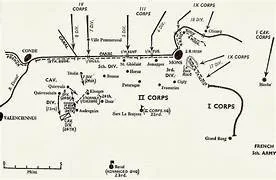A Battle of Mons Photograph. What is wrong with the caption?
Troops of A Company 4th Batt. Royal Fusiliers (7th Brigade, 3rd Division), resting in the Grand Place, Mons. The following day the Battalion won two Victoria Crosses (Lieutenant Maurice Dease and Private Sydney Godley) on the Canal bridge at Nimi 2 miles north of Mons.(IWM Q70071)
This image is familiar because of its reproduction in many books and articles relating to the Battle of Mons on 23 August 1914. I have always had problems with the caption, and I will try and explain my concerns.
I accept that the troops in the photograph are A Company 4th Battalion Royal Fusiliers and that they are sitting on the cobbles in the Grand Place in Mons in front of the Town Hall. My problem is the assumption that this image was taken on Saturday 22nd August 1914 while the battalion was on its way to take up positions on the canal.
My contention is that it was taken during the afternoon of Sunday 23rd during the short period when the survivors of the battalion rested in the town to regroup during its fighting withdrawal from the canal where they had been engaged against overwhelming odds since dawn.
My Evidence.
(a) The movements of the battalion on Saturday 22nd August. The march to the Mons Canal from overnight billets at. Le Longueille, beginning at 5:30 am, the battalion acting as advanced guard to the 7th Infantry Brigade. Their orders were to take up an outpost position at Nimmi guarding the crossings of the Canal which they were expected to reach mid-afternoon but were delayed passing through Mons by crowds of cheering inhabitants who loaded the marching troops with presence of eggs, fruit, tobacco, and even handkerchiefs.
(b) Reached the canal in early evening and spent the hours of darkness preparing defences
(c) The Battle
The battalion occupied salient created by the Canal between Mons and Nimy:
C Company lay north of Nimy with its right adjoining the 4th Middlesex, and it’s left a little north of Lock 6. Two platoons held Nimy Bridge, two others and Company H.Q. were entrenched at the railway bridge and on the canal bank to the left.
D Company held the position about Lock 6 and the Ghlin-Mons bridge.
B Company lay about Nimy station in support, with Battalion H.Q.
A Company was the battalion reserve north of Mons.
The German attack began in early in the morning with artillery and infantry. By about 11am, it was apparent that the battalion could not hold the enemy and were ordered to prepare to retire. Once consequence of this warning order was that the ammunition boxes were removed from the trenches leading to a shortage of ammunition before the actual order to retire was given at 1.40 pm. ‘C’ Company, the most seriously engaged, lost about 75 men and fell back towards Mons, and when they were clear of their positions ‘D’ Company, which had been covering their withdrawal, also retired to join up with ‘C’ and ‘B’ Companies, with all three retiring towards Mons covered by ‘A’ company as rearguard.
‘A’ company rejoined the rest of the battalion in the Grand Place where the battalion rested for about 15 minutes while the officers and NCOs sorted the men out into their Companies before continuing their retirement. During this time the German infantry was held at bay by the sharpshooters of ‘A’ Company firing down the streets from the cover of houses. As soon as the 4th Royal Fusiliers is left the Grand Place troops of the 84th Regiment, 18th Division, IX Corps entered and rounded up some of the civilians, including the Burgomaster, and drove them in front of them as human shields when they started after the Royal Fusiliers.
Back to the Photograph.
· There are civilians in the photograph, but the majority are men and boys just milling around among the soldiers with no evidence of the cheering crowds handing the soldiers small gifts of tobacco, eggs etc., as recorded when the battalion passed through the town on the Saturday afternoon.
· The soldiers sitting in the Grand Place look exhausted, there is no sign of their packs, rifles close at hand, and many are carrying additional bandoliers of ammunition, something unnecessary on the Saturday when marching to the canal.
These are what one would expect if they were resting after a fighting retreat to get clear of the German infantry and points to the photograph being taken on the afternoon of Sunday 23rd, and not the day before.

